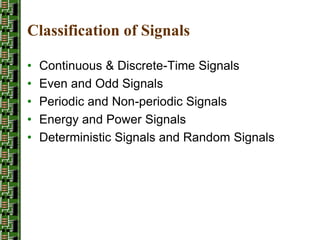S&s lec1
- 1. Prepared By: SYED HAMZA FAISAL
- 2. Signals & Systems âĒ Signals and systems introduction and mathematical background âĒ Signal classification and energy, basic operations with signals, useful signals âĒ Systems - examples and classification, LTI systems âĒ LTI systems and the impulse response - Convolution âĒ Linear systems: zero-input and zero-state response âĒ The trigonometric Fourier series as a convenient signal representation for LTI systems analysis âĒ The exponential Fourier series - Fundamental frequency and properties âĒ Beyond Fourier Series - The Fourier Transform âĒ Existence condition, inverse transform, useful Fourier transforms âĒ Properties of the Fourier transform âĒ LTI systems and the Fourier transform âĒ Laplace Transform, Properties of Laplace transform âĒ Inverse Laplace transform âĒ Z-transform , Region of convergence, The inverse Z-transform , More on the Z-transform ,Left and right hand signals , Stable and unstable signals ,Causal and anti-causal signals
- 3. Signals Signals are functions of independent variables that carry information. For example: Electrical signals â Voltages and currents in a circuit Acoustic signals â Acoustic pressure (sound) over time Mechanical signals â Velocity of a car over time Video signals â Intensity level of a pixel (camera, video) over time
- 4. How is a Signal Represented? âĒ Mathematically, signals are represented as a function of one or more independent variables. âĒ For instance a black & white video signal intensity is dependent on x, y coordinates and time t f(x,y,t) âĒ On this course, we shall be exclusively concerned with signals that are a function of a single variable: time t f(t)
- 5. What is System? âĒ Systems process input signals to produce output signals âĒ A system is combination of elements that manipulates one or more signals to accomplish a function and produces some output. system output signal input signal
- 6. Examples of Systems â A circuit involving a capacitor can be viewed as a system that transforms the source voltage (signal) to the voltage (signal) across the capacitor â A communication system is generally composed of three sub-systems, the transmitter, the channel and the receiver. The channel typically attenuates and adds noise to the transmitted signal which must be processed by the receiver â Biomedical system resulting in biomedical signal processing â Control systems
- 8. Communication Systems o A communication system conveys information from its source to a destination. o Examples: o Telephone o TV o Radio o Cell phone o Satellite
- 9. Communication Systems o A communication system is composed of the following: Fig. 1 Block Diagram of Communication System
- 10. Basic Components of a Communication System âĒ Input Transducer o Source: Analog or digital o Example: Speech, music, written text, pictures o Input Transducer: Converts the message produced by a source to a form suitable for the communication system. o Example: o Speech wavesï Microphoneï Voltage
- 11. Transmitter o Prepare the Input signal for actual transmission over the communication channel e.g. Modulation o Examples: TV station, radio station, web server
- 12. Channel o Physical medium that does the transmission o Examples: Air, wires, coaxial cable, radio wave, laser beam, fiber optic cable o Every channel introduces some amount of distortion, noise and interference
- 13. Receiver o Job of receiver also includes to undo all the harmful degradation introduced by channel e.g. noise introduced by channel o Demodulation: Extracts message from the received signal o Operations: Amplification, Demodulation, Filtering o Examples: TV set, radio, web client
- 14. Output Transducer o Converts electrical signal into the form desired by the system o Examples: Loudspeakers, PC
- 16. Modulation o Modulation is an important step of communication system. Modulation is defined as the process whereby some characteristic (amplitude, frequency, phase of a high frequency signal wave (carrier wave) is varied in accordance with instantaneous value intensity of low frequency signal wave (modulating wave.) 16 )cos( cctwA ïąïŦ
- 17. Modulation o Modulation is a process that causes a shift in the range of frequencies in a signal o Two Type of communications o In baseband communication baseband signals are sent without any shift in the range of frequencies o Any communication that uses modulation of a high-frequency carrier signal is called carrier communication 17
- 18. Pulse Code Modulation(PCM) âĒ Pulse code modulation is used to convert an analog data to digital signal(digitization). âĒ A PCM encoder has three processes 1.The analog signal is sampled 2.The sampled signal is quantized. 3.The quantized values are encoded as stream of bits.
- 19. Components of PCM encoder
- 20. Quantization and encoding of a sampled signal
- 21. Components of a PCM decoder
- 22. Modes of Communications âĒ There are two basic modes of Communications âĒ Broadcast(Single Tx and Multiple Rxs) â Radio and Tv âĒ Point-To-Point Communication â Single Transmitter single Receiver â Telephone systems â Deep Space Communication(link b/w earth station and robot navigating the surface of distant planet) â Pathfinder Robot landed on Mars on July 4, 1997, a historic day in the National Aeronautics and Space Administrationâs(NASAâs)
- 23. Classification of Signals âĒ Continuous & Discrete-Time Signals âĒ Even and Odd Signals âĒ Periodic and Non-periodic Signals âĒ Energy and Power Signals âĒ Deterministic Signals and Random Signals
- 24. Continuous & Discrete-Time Signals âĒ Continuous-Time Signals âĒ Most signals in the real world are continuous time, as the scale is infinitesimally fine. âĒ Eg voltage, velocity, âĒ Denote by x(t), where the time interval may be bounded (finite) or infinite âĒ Discrete-Time Signals âĒ discrete time signals are defined only at discrete instants of time. âĒ E.g. pixels, daily stock price (anything that a digital computer processes) âĒ Denote by x[n], where n is an integer value that varies discretely âĒ Sampled continuous signal âĒ x[n] =x(nT) is sample time x(t) t x[n] n
- 25. Even and Odd Signals Even Functions Odd Functions g tïĻ ïĐï― g ïtïĻ ïĐ g tïĻ ïĐï― ïg ïtïĻ ïĐ
- 26. Even and Odd Parts of Functions ïĻ ïĐ ïĻ ïĐ ïĻ ïĐg g The of a function is g 2 e t t t ïŦ ï ï―even part ïĻ ïĐ ïĻ ïĐ ïĻ ïĐg g The of a function is g 2 o t t t ï ï ï―odd part Ex 1.1 see book
- 27. Various Combinations of even and odd functions Function type Sum Difference Product Quotient Both even Even Even Even Even Both odd Odd Odd Even Even Even and odd Neither Neither Odd Odd
- 28. Discrete Time Even and Odd Signals ï ï ï ï ï ïg g g 2 e n n n ïŦ ï ï― ï ï ï ï ï ïg g g 2 o n n n ï ï ï― ï ï ï ïg gn nï― ï ï ï ï ïg gn nï― ï ï
- 29. Combination of even and odd function for DT Signals Function type Sum Difference Product Quotient Both even Even Even Even Even Both odd Odd Odd Even Even Even and odd Even or Odd Even or odd Odd Odd
- 30. Periodic and Non-periodic Signals âĒ Given x(t) is a continuous-time signal âĒ x (t) is periodic if x(t) = x(t+Tâ) for any T and any integer n âĒ Example â x(t) = A cos(wt) â x(t+Tâ) = A cos[w(t+Tâ)] = A cos(wt+wTâ)= A cos(wt+2p) = A cos(wt) â Note: Tâ =1/fâ ; w=2pfâ
- 31. Periodic and Non-periodic Signals Contd. âĒ For non-periodic signals x(t) â x(t+Tâ) âĒ Example of non periodic signal is an exponential signal âĒ See problem 1.3
- 32. Important Condition of Periodicity for Discrete Time Signals âĒ A discrete time signal is periodic if x(n) = x(n+N) âĒ For satisfying the above condition the frequency of the discrete time signal should be ratio of two integers i.e. fâ = k/N
- 33. Energy and Power Signals Energy Signal âĒ A signal with finite energy and zero power is called Energy Signal i.e.for energy signal 0<E<â and P =0 âĒ Signal energy of a signal is defined as the area under the square of the magnitude of the signal. âĒ The units of signal energy depends on the unit of the signal. ïĻ ïĐ 2 x xE t dt ïĨ ïïĨ ï― ïē
- 34. Energy and Power Signals Contd. Power Signal âĒ Some signals have infinite signal energy. In that caseit is more convenient to deal with average signal power. âĒ For power signals 0<P<â and E = â âĒ Average power of the signal is given by ïĻ ïĐ /2 2 x /2 1 lim x T T T P t dt TïŪïĨ ï ï― ïē
- 35. Energy and Power Signals Contd. âĒ For a periodic signal x(t) the average signal power is âĒ T is any period of the signal. âĒ Periodic signals are generally power signals. ïĻ ïĐ 2 x 1 x T P t dt T ï― ïē
- 36. Signal Energy and Power for DT Signal âĒThe signal energy of a for a discrete time signal x[n] is ï ï 2 x x n E n ïĨ ï―ïïĨ ï― ïĨ âĒA discrtet time signal with finite energy and zero power is called Energy Signal i.e.for energy signal 0<E<â and P =0
- 37. Signal Energy and Power for DT Signal Contd. The average signal power of a discrete time power signal x[n] is ï ï 1 2 x 1 lim x 2 N N n N P n N ï ïŪïĨ ï―ï ï― ïĨ ï ï 2 x 1 x n N P n N ï― ï― ïĨ For a periodic signal x[n] the average signal power is The notation means the sum over any set of consecutive 's exactly in length. n N n N ï― ïĶ ïķ ï§ ï· ï§ ï· ïĻ ïļ ïĨ























![Continuous & Discrete-Time Signals
âĒ Continuous-Time Signals
âĒ Most signals in the real world are
continuous time, as the scale is
infinitesimally fine.
âĒ Eg voltage, velocity,
âĒ Denote by x(t), where the time interval
may be bounded (finite) or infinite
âĒ Discrete-Time Signals
âĒ discrete time signals are defined only at
discrete instants of time.
âĒ E.g. pixels, daily stock price (anything
that a digital computer processes)
âĒ Denote by x[n], where n is an integer
value that varies discretely
âĒ Sampled continuous signal
âĒ x[n] =x(nT) is sample time
x(t)
t
x[n]
n](https://image.slidesharecdn.com/ss-lec1-170808081206/85/S-amp-s-lec1-24-320.jpg)





![Periodic and Non-periodic Signals
âĒ Given x(t) is a continuous-time signal
âĒ x (t) is periodic if x(t) = x(t+Tâ) for any T and any integer
n
âĒ Example
â x(t) = A cos(wt)
â x(t+Tâ) = A cos[w(t+Tâ)] = A cos(wt+wTâ)= A
cos(wt+2p) = A cos(wt)
â Note: Tâ =1/fâ ; w=2pfâ](https://image.slidesharecdn.com/ss-lec1-170808081206/85/S-amp-s-lec1-30-320.jpg)





![Signal Energy and Power for DT
Signal
âĒThe signal energy of a for a discrete time signal x[n] is
ï ï
2
x x
n
E n
ïĨ
ï―ïïĨ
ï― ïĨ
âĒA discrtet time signal with finite energy and zero
power is called Energy Signal i.e.for energy signal
0<E<â and P =0](https://image.slidesharecdn.com/ss-lec1-170808081206/85/S-amp-s-lec1-36-320.jpg)
![Signal Energy and Power for DT
Signal Contd.
The average signal power of a discrete time power signal
x[n] is
ï ï
1
2
x
1
lim x
2
N
N
n N
P n
N
ï
ïŪïĨ
ï―ï
ï― ïĨ
ï ï
2
x
1
x
n N
P n
N ï―
ï― ïĨ
For a periodic signal x[n] the average signal power is
The notation means the sum over any set of
consecutive 's exactly in length.
n N
n N
ï―
ïĶ ïķ
ï§ ï·
ï§ ï·
ïĻ ïļ
ïĨ](https://image.slidesharecdn.com/ss-lec1-170808081206/85/S-amp-s-lec1-37-320.jpg)